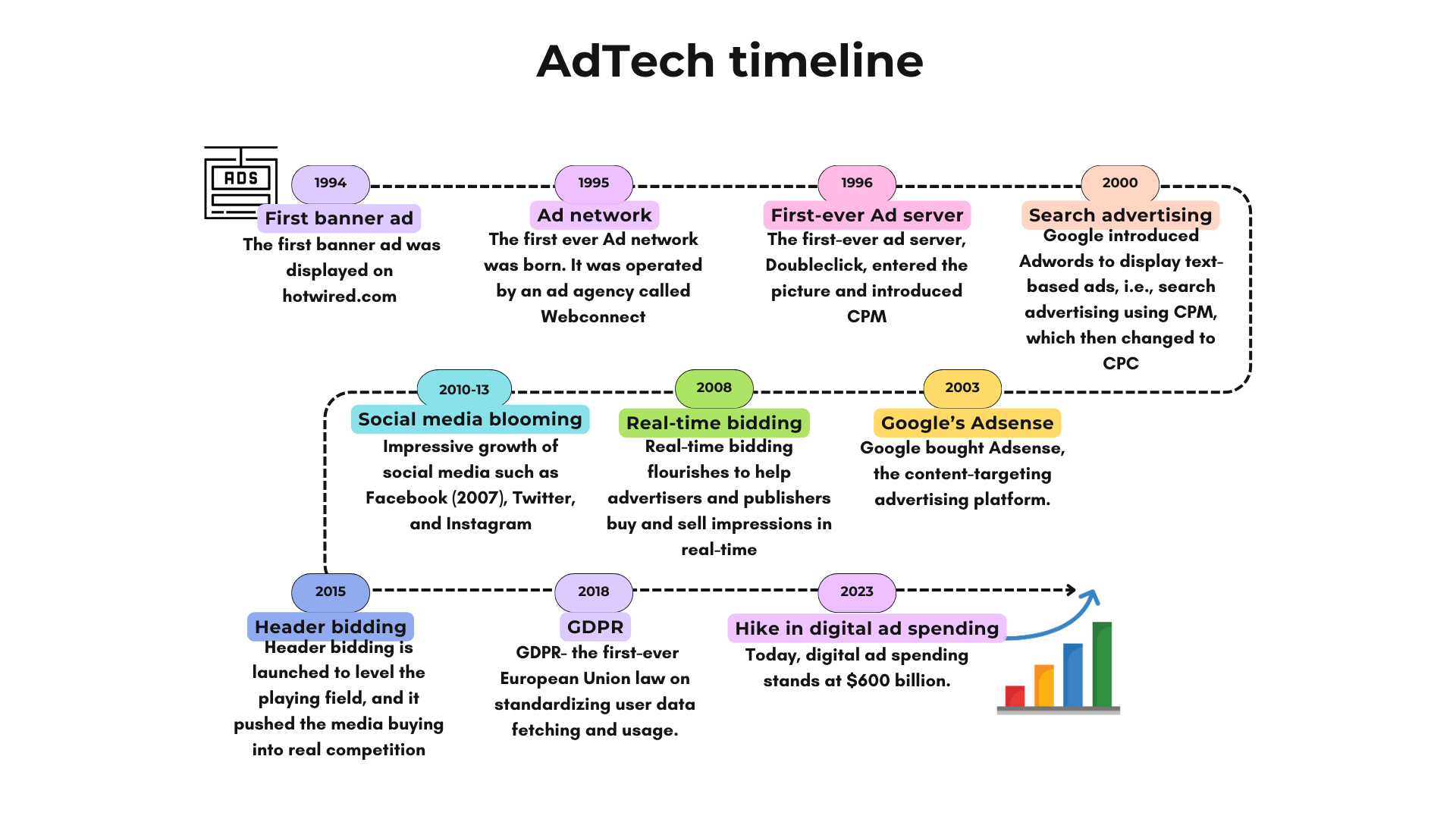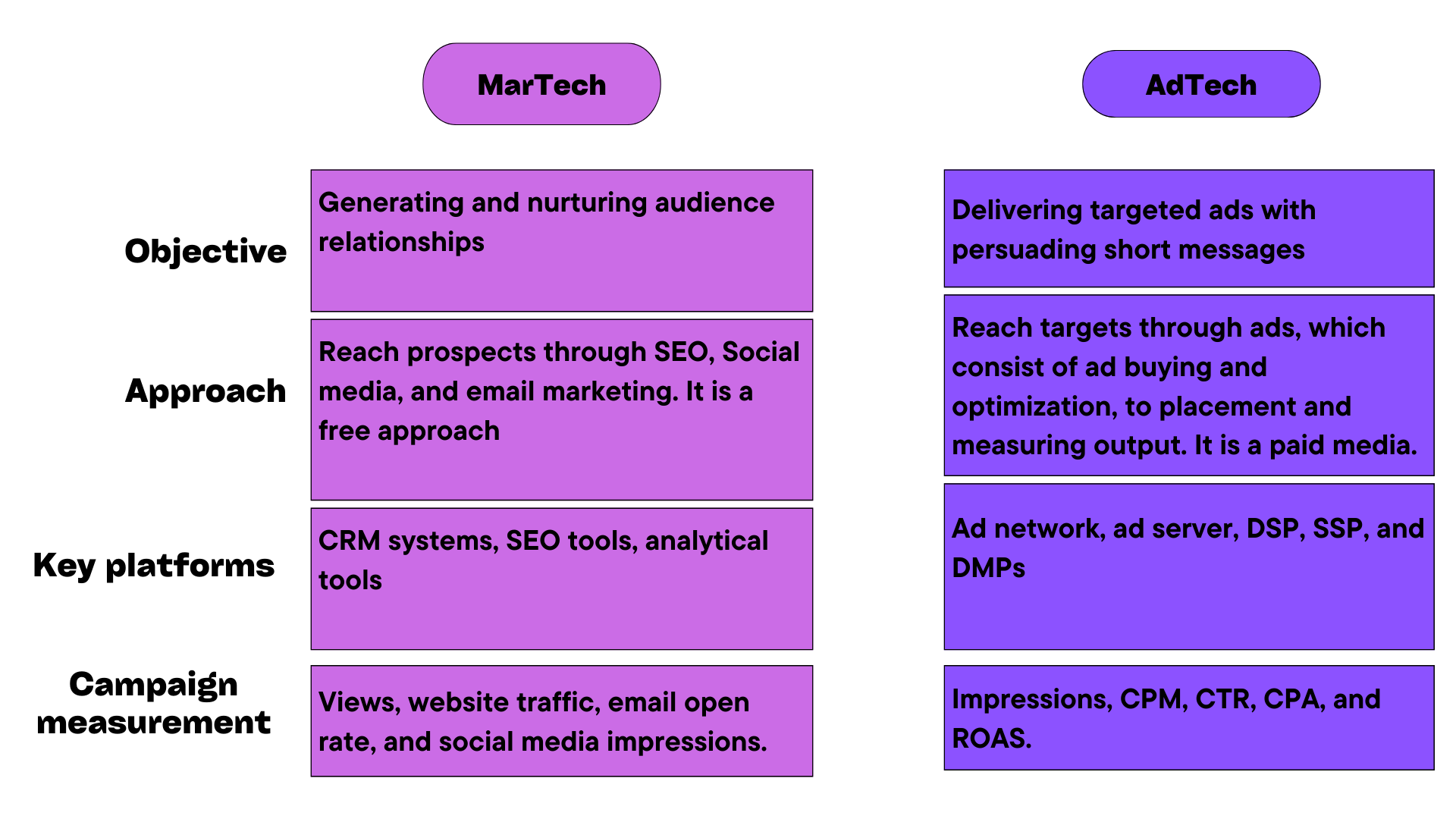Ads have become integral to every business and the whole digital ecosystem. That is why the ad spending is increasing enormously YOY. It stands at $600 billion and is forecasted to reach $900 billion in 2027.
The technology around ad display and viewing has also seen tremendous changes over the years and made way for the new disciple “AdTech. This extensive guide gives you a clear ground on the basics of adtech, its benefits, its governing body, and everything you need to know.
Table of Contents
What is AdTech?
AdTech is a domain that contains different software and tools to help brands, services, and publishers perform effective ad buying and selling. They help them analyze, strategize, and deliver better digital advertising campaigns.
AdTech streamlines the ad buying and selling process as it becomes more complex with competition. The elements of the adtech domain, such as ad servers, ad networks, ad exchange, DSP, SSP, real-time bidding, etc., form the adtech ecosystem. It provides a way for better ad campaigns and higher yields in website monetization.
Evolution of AdTech

Key Players of AdTech
Generally, adtech consists of source-side and demand-side. The key players on the source and demand side are publishers, advertisers, users, and adtech providers.
Publishers: The ones who post content online on websites, magazines, news media, and social networks. They are on the source or supply side, meaning they have the space to show ads. They can sell those spaces to brands and services for money. They have valuable user traffic and customer data, which can be accessed by the brands and services to reach their targets.
Advertisers: Brands, services, and marketers are a few examples of advertisers. They are demand-side, who buy ad spaces on the online channels like websites and mobile app. They reach their target audience by displaying ads on the website or app with potential traffic and user data.
Internet users: The audience that consumes content generated by publishers and advertisers, including content, video, audio, ads, etc.
AdTech providers: The providers who enable effective ad space buying and selling using technological elements. The elements include ad servers, ad exchange, DSP, SSP, DMP, etc.
Advertising agencies, trading desks, and ad networks are great instances of ad tech providers. They optimize media buying and selling and connect advertisers to multiple supply sides to get high revenue and ROI.
AdTech Ecosystem
The integral platforms or intermediaries in adtech enhance ad space buying and selling. The list is below.

An ad network is a platform aggregating publishers’ inventory space and selling it to advertisers with a markup. They can be considered ad brokerage, which collects ad space in an auction and resells it to advertisers by setting up a campaign.
Advertisers can buy the ad space based on user traffic, budget, and demographics like age, gender, and location. It is not highly targeted. Publishers and advertisers will not have direct contact. The control and transparency over the media buying process are very low.
Ad networks are suitable for publishers and advertisers starting their journey in digital advertising. Some popular ad networks are Google Adsense and Google AdMob, which are used by 90% of the publishers who use ad network SDKs, Yahoo Gemini, and Media.net.
Ad exchange (AdX):
This platform allows publishers to list their ad space and conducts a real-time auction to let advertisers bid on impressions. Publishers connect to ad exchange through the supply-side platform (SSP), and advertisers connect to AdX through the demand-side platform (DSP).
Publishers list their ad inventory in SSP, and SSP sents the requirements to an ad exchange. It conducts the real-time auction by letting the advertisers bid on the available impressions.
Publishers and advertisers have more control over the process. Publishers can set minimum CPM prices and the types of ad formats they want to display to reduce spammy content.
Advertisers can choose ad space according to budget, granular targeting metrics, and frequency cap. Some popular ad exchanges are Google Ad Exchange, OpenX, PubMatic, and Magnite.
The purpose of the ad server is to serve ads on the website or app and track the performance of those ads. Publishers, advertisers, ad agencies, and ad networks use ad servers. It uses automated technologies to select the ad that bids high and place ads on the website. It knows which ads to place and where to place ads.
Hence, it is the central place to manage ad campaigns, tracking and reporting the output. Google Ad Manager, EPOM, and OpenX are a few examples of popular ad servers.
Supply-side platform (SSP):
SSP is a platform or a tool for publishers to put their requirements and automate the process of selling impressions, including display, video, and mobile ads.
It lets the ad exchange know about the impression available and the requirements of the ad creative suitable for the ad space. From there, ad exchange makes the impressions available to the potential buyers.
Nowadays, the gap between the SSP and ad exchange is blurring. Many service companies develop SSPs with ad exchange abilities to offer comprehensive solutions for publishers. Some popular SSPs are Amazon publisher services, Xandr, Index Exchange, etc. Google Ad Manager secures the top #1 SSP place in the U.S.
The software allows advertisers to access the potential ad inventory listed in the ad exchange, including display, video, and mobile ads. The advertisers select the ad space according to their budget and with more granular targeting metrics apart from user traffic, context, and demographics to reach their targets.
After selection, they bid on the impression in a real-time auction equal to or above the floor price. Some popular DSPs are Amazon, Xandr, Google’s Display and Video 360, and Yahoo.
This platform is the source of data that collects first, second, and third-party data to make a comprehensive list of user details for more detailed targeting.
Publishers and advertisers contact DMP to collect enriched user data and show ads to the most specific user. With the wholesome data of DMP, advertisers can reduce ad spending and increase ROI by investing only in websites with potential targets.
The marketer or publisher sends the data requirement of who they want data for—for instance, a female aged 20 to 40 who likes fur coats. The DMP sends the user data to advertisers to target users with relevant or personalized ads. Oracle, Salesforce, and IBM are a few top data management platforms.
Agency trading desk (ATD):
ATD is an agency that provides a set of services for advertisers, like buying, placing, and managing ad campaigns. ATD is an option for marketers who are not ready to use DSP or cannot form their in-house team.
The agencies staff a trading desk with data analysts, account managers, software developers, designers, and other professionals to form an expert adops team. They manage and promote ad campaigns and offer analytics on media buying for advertisers across different platforms.
Programmatic advertising is a major effective twist in the ad tech industry. It is an automated way of buying and selling digital ad space. The platforms we have discussed, like DSP, SSP, and ad exchanges, are also elements of programmatic advertising.
This element uses different software and algorithms to automate media buying and serve the right ads to the right audience in the right context. Programmatic media buying occurs in real-time, is auction-based, is highly targeted, and is highly effective.
Publishers get high CPMs for their ad inventory, and advertisers get high ROI on their ad campaigns.
Governing Body of AdTech Ecosystem
The Interactive Advertising Bureau (IAB) is the governing body of the adtech ecosystem. They develop industry standards and offer legal support for the online advertising industry. It was established in 1996 in New York and works primarily in the US and Europe.
IAB offers various services for digital advertising that include:
- Industry-standard guidance and support to marketers in media buying and selling.
- They regulate the advertising ecosystem with data privacy laws such as CPRA and CPDA.
- Resources that are research-backed and deliver studies of success stories of certain ad types.
- Support and counsel for legal matters.
- They also help companies in data attribution.
In general, IAB answers questions like how to develop effective ads, create legal and interactive PPC ads, what the company has to do to ensure the PPC ads are legal, and so on. This governing body helps companies with everything they need to make data-driven decisions and perform effective media buying.
MarTech Vs. AdTech
These two terms are often confused for one, but they are not alike. MarTech stands for marketing technology, and AdTech stands for ad technology.
MarTech streamlines marketing efforts with a set of tools and software. It represents the collection of marketing efforts and uses technology to automate, optimize, and measure the efforts across different channels. Blogging, social media promotions, newsletters, and email marketing are some examples of marketing efforts.
On the other hand, ad tech focuses on effective ad space buying and selling and possesses effective intermediary software to automate the process.
Marketing is a set of efforts and actions to reach and attract audiences. It boosts awareness, strength, brand value, and sales.
Advertising is one of the marketing activities through which you deliver effective messages to raise awareness, create interest, and take desired action across different channels. The desired action includes giving email IDs for e-book downloads and sign-up forms and watching a demo.

Benefits of AdTech
AdTech is evolving and improving digital campaigns with new steps such as digital vernacularism, reliance on first-party data, and changing the digital narrative with personalized ads.
Adtech is extremely automated now as machine learning is improving at processing huge amounts of information in milliseconds. Programmatic advertising is also reaching new heights with streaming TV and audio ads.
Check out the following three key benefits of such an effective adtech industry:
Effectively utilized ad budget:
Unlike traditional advertising, you can show ads to audiences interested in the product and services in the adtech. It helps advertisers show the right ads to the right audience with first and third-party data. Eventually, ad spending will be utilized better, and the ad budget will be minimal compared to traditional advertising.
High-efficient ad campaigns:
AdTech helps advertisers, ad agencies, and publishers analyze and measure campaign performance with effective tools. The analysis and performance tracking tools give a bird-eye view of where the ads are placed and how they perform. Thus, it increases productivity and saves time in the media buying process.
Better ROI:
The two vital players of the adtech (publishers and advertisers) can reap more than what they spend. Publishers with enriched first-party data and reputable websites can achieve high CPMs for the ad space, whereas advertisers can spend a minimum on potential ad space and get high ROI.
Since advertisers invest in ad spaces that let them reach specific target audiences and increase conversions, the ad budget is less. They can reach targets according to the marketing funnel where they stand, such as brand awareness, consideration, and conversion, and spend accordingly.
Touching Heights with AdTech
As adtech is growing exponentially, the software and tools of adtech are becoming more sophisticated. The adtech allows you to integrate multiple platforms, data-sharing, make data-driven decisions, reach targets across different channels, reduce time with narrow targets, track and analyze performance, and get the best output.
Seeing the growth of adtech in the last three decades, it is not showing any signs of slowing. Utilizing ad tech nowadays moves around with multiple parameters, adapting to changes, catching new trends, and utilizing them with a fine twist. Ultimately, AdTech lets you focus on more highly creative work, provides value, and positively reflects the output.























